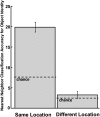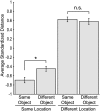A cognitive map for object memory in the hippocampus
- PMID: 19794187
- PMCID: PMC2769165
- DOI: 10.1101/lm.1484509
A cognitive map for object memory in the hippocampus
Abstract
The hippocampus has been proposed to support a cognitive map, a mental representation of the spatial layout of an environment as well as the nonspatial items encountered in that environment. In the present study, we recorded simultaneously from 43 to 61 hippocampal pyramidal cells as rats performed an object recognition memory task in which novel and repeated objects were encountered in different locations on a circular track. Multivariate analyses of the neural data indicated that information about object identity was represented secondarily to the primary information dimension of object location. In addition, the neural data related to performance on the recognition memory task. The results suggested that objects were represented as points of interest on the hippocampal cognitive map and that this map was useful in remembering encounters with particular objects in specific locations.
Figures







References
-
- Bachevalier J, Nemanic S. Memory for spatial location and object-place associations are differently processed by the hippocampal formation, parahippocampal areas TH/TF and perirhinal cortex. Hippocampus. 2008;18:64–80. - PubMed
-
- Bunsey M, Eichenbaum H. Conservation of hippocampal memory function in rats and humans. Nature. 1996;379:255–257. - PubMed
-
- Burgess N, Maguire EA, O'Keefe J. The human hippocampus and spatial and episodic memory. Neuron. 2002;35:625–641. - PubMed
-
- Burwell RD, Shapiro ML, O'Malley MT, Eichenbaum H. Positional firing properties of perirhinal cortex neurons. Neuroreport. 1998;9:3013–3018. - PubMed
Publication types
MeSH terms
Grants and funding
LinkOut - more resources
Full Text Sources
Other Literature Sources
Medical
